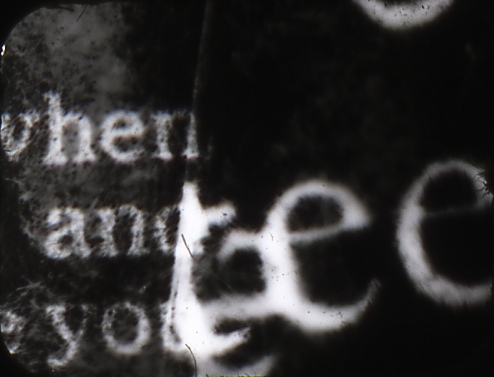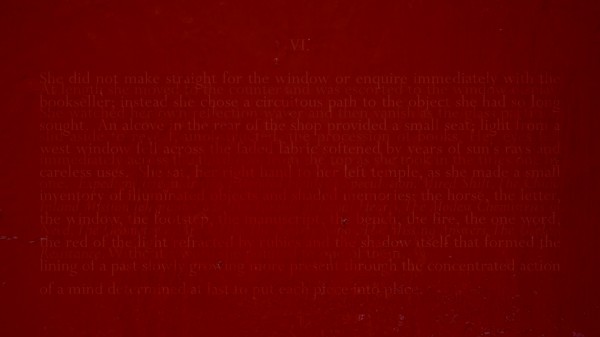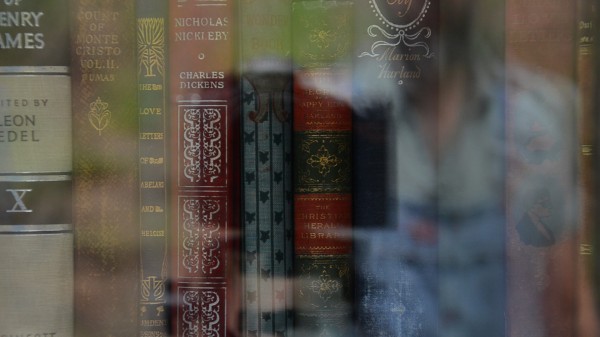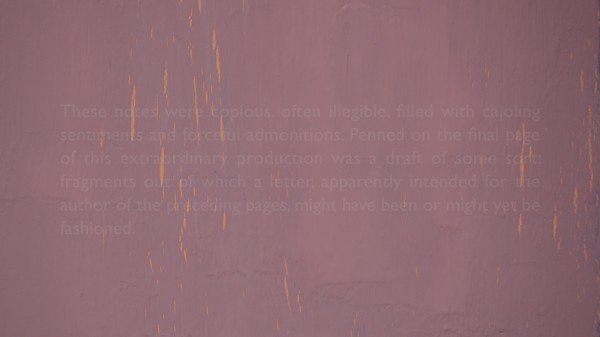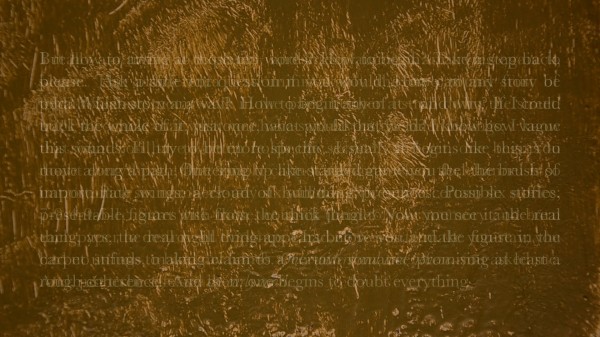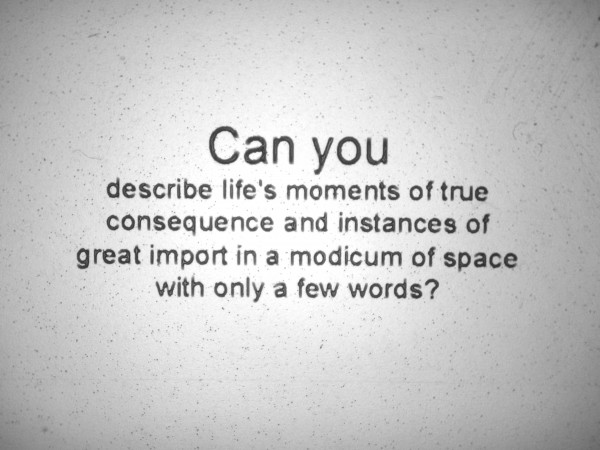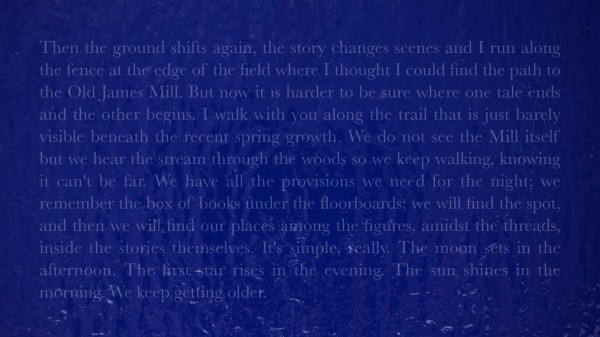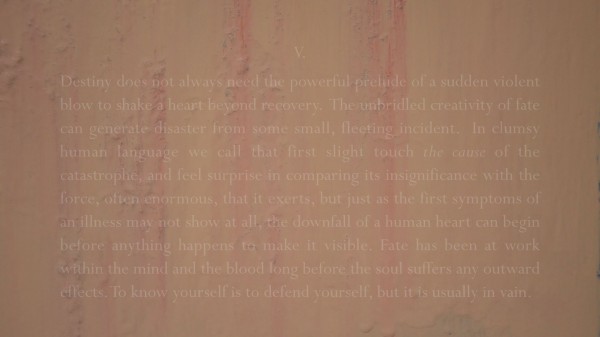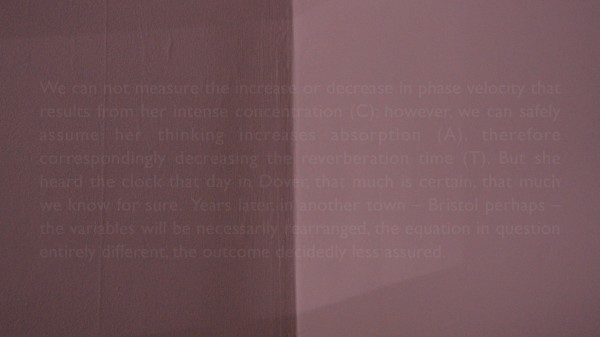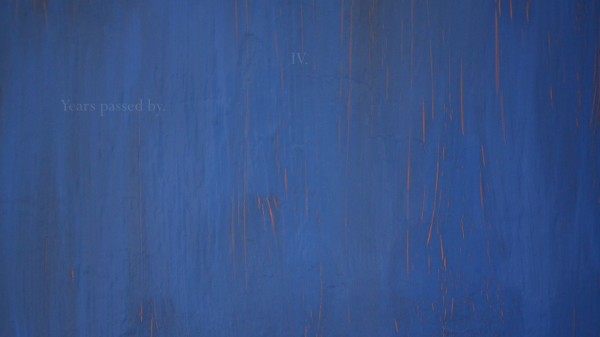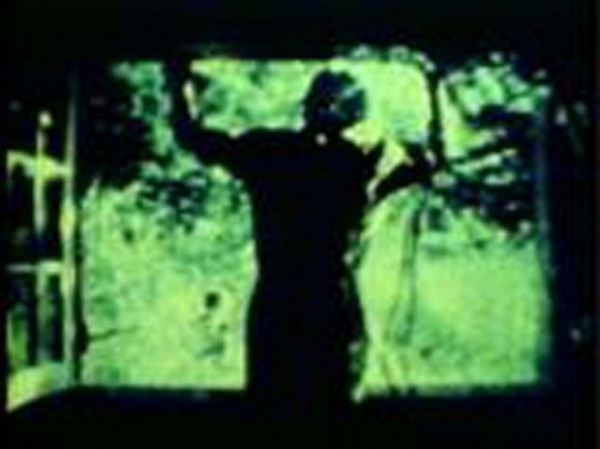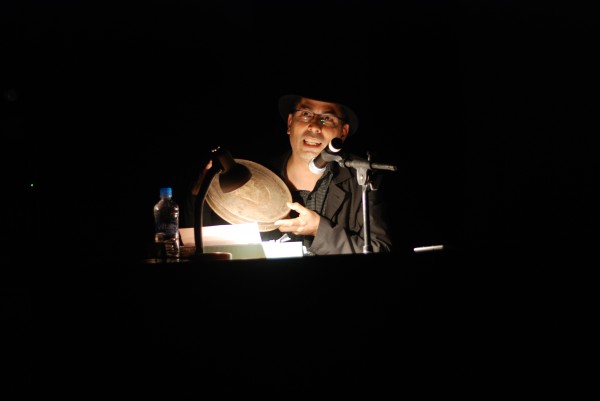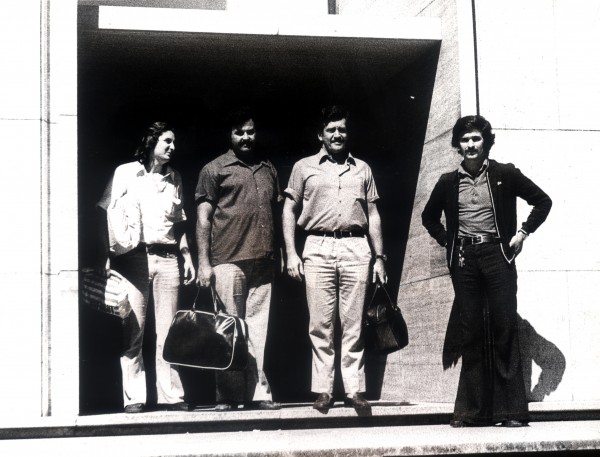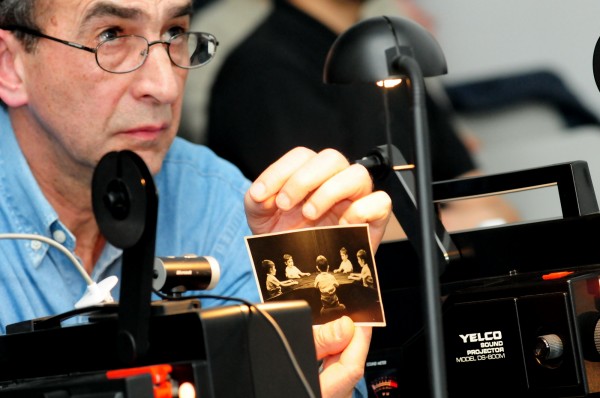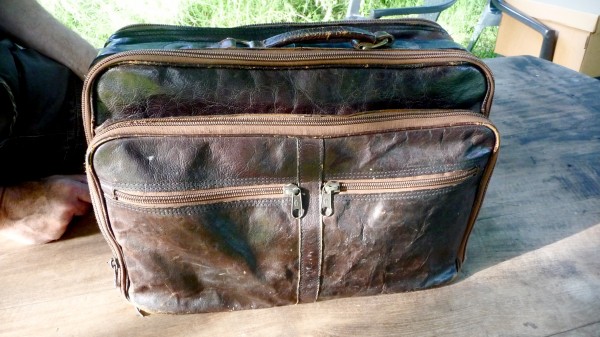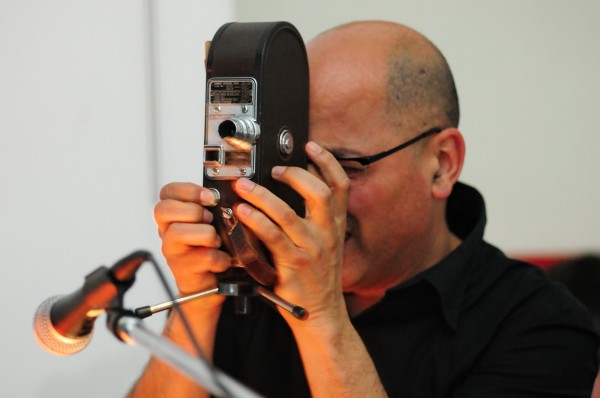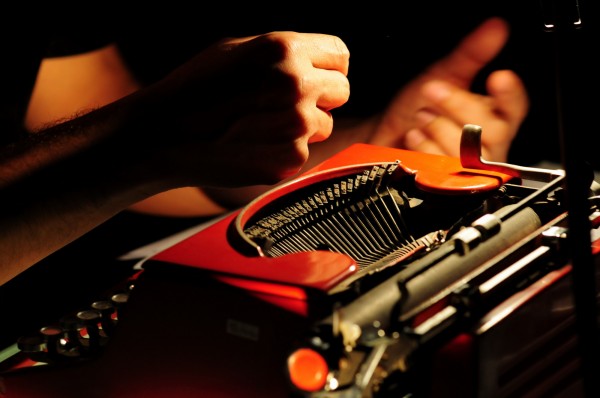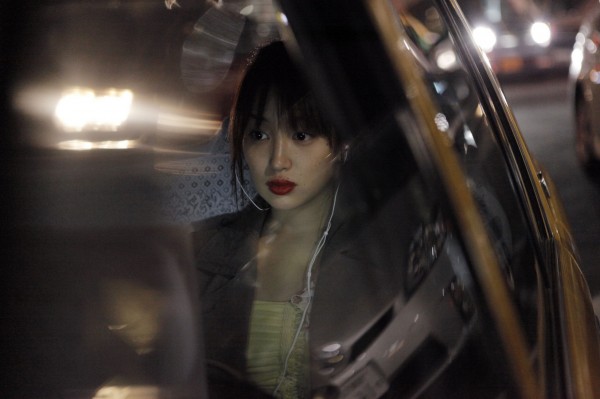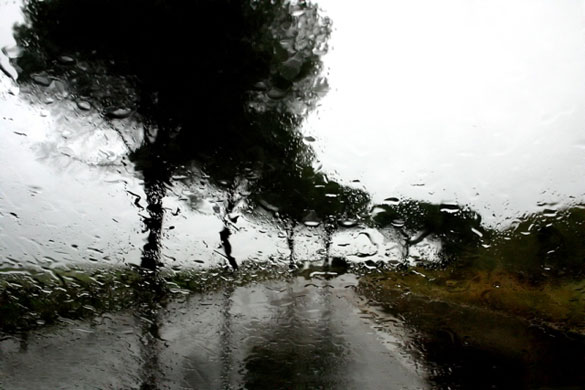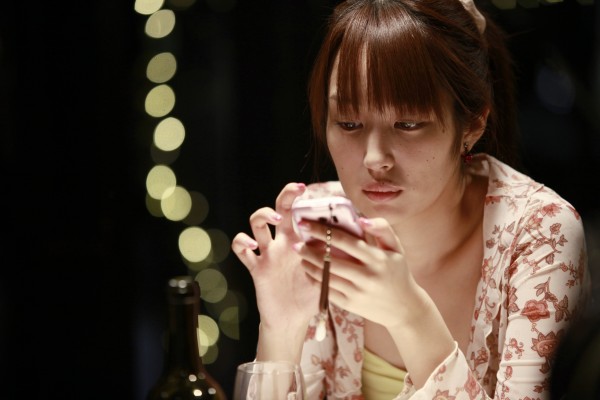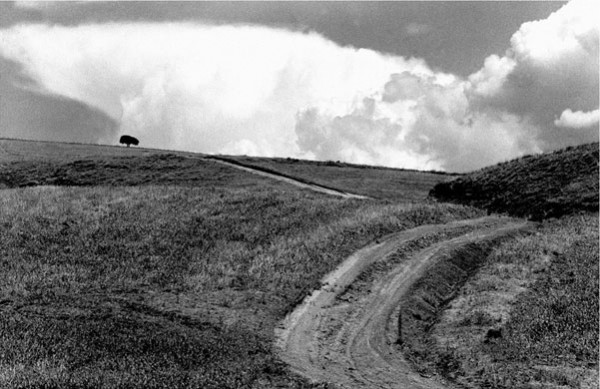It was an October afternoon last year at the Brooklyn screening space UnionDocs, and our group of five was awaiting David Gatten. He arrived distinctly attired—small-lensed glasses, a scraggly beard, overalls, and a heavy knapsack, from which he removed prints of eight of his eighteen completed 16mm films. Some he hadn’t brought because he’d made them to be shown at an outdated projector speed; one was unavailable because his print remained in California under an old girlfriend’s care. But the films he had on hand he would project himself and discuss with us.
This is a frequent practice for Gatten, who was in New York for the world premiere of his latest work, The Extravagant Shadows, at the New York Film Festival’s Views from the Avant-Garde sidebar. We arranged our private screening because we might never see his remaining works otherwise. His films are unique art objects, rendering chances to view them rare. He explained that no more than three prints of any exist; some, like the What the Water Said series (unprocessed filmstrips exploding with sound and color, the product of Gatten leaving them floating in crab traps off the South Carolina coast), could never be reproduced. Each time a film of his runs through a projector, he said, it dies a little.
These delicate, fragile works need care and attention to survive, much like a key Gatten subject: love. And like much of the output of his self-professed model, Hollis Frampton (whose ode to his own maternal grandmother, Gloria! [1979], is Gatten’s favorite film), they devote themselves to building systematic frames within which love can be articulated. The frames are often made from forms of written language, whether densely coded Western Union messages (Film for Invisible Ink, case no. 323: ONCE UPON A TIME IN THE WEST [2010], prepared for his wedding to fellow filmmaker Erin Espelie) or phrases plucked out of direct, despairing summons written to a beloved from across an ocean (The Great Art of Knowing [2004]). His most celebrated project has been an ongoing nine-part film series, begun in the late 1990s, called The Secret History of the Dividing Line, with each entry named after a book belonging to 18th-century Richmond, Virginia founder William Byrd II, whose library contained over 4,000 volumes. The series’ four completed films, all silent (though Gatten prefers to call them quiet) and three of the four in black-and-white, tremble with close-ups of thick, richly engraved words soon to disappear from sight.
It takes words much longer to vanish in The Extravagant Shadows, Gatten’s first digital work, which will be screening again in New York (in a session curated by Views programmer Mark McElhatten) at Lincoln Center on Monday, April 29 at 7 P.M. with Gatten in person. They fade in, ghostlike, forming cryptic messages over layers of paint with which the artist has covered a bookcase’s glass front, then haunt the screen for several minutes as they fade back out. Though many originally come from other writers, including Stefan Zweig, Maurice Blanchot, and Henry James (from whose short story “The Jolly Corner” Gatten took Shadows’ title), the tale that they obliquely tell—made up of overlapping possible stories that lovers might share, if chance allows—is of Gatten’s invention.
How did you learn to read?
I cannot completely remember learning to read, but I know that books were always a tremendously important part of the household. We did not listen to a lot of music. Music was not on all the time, and was a very special event when it was played. Books formed the architecture of our home. My mother majored in Shakespeare at William & Mary. My father would read to us for an hour every night and my mother would read on the weekends. My earliest memories of literature are of having it read aloud to me. I am certain that Dr. Seuss was an important beginning, and I feel like I learned to read and took pleasure in reading early on. My parents would take us to the library every week, where we were allowed only three books. That wasn’t a library policy, but a family policy, which put into place an idea of scarcity, and a need to then choose carefully. Books were serious and special things. So I spent all of my allowance money on buying them.
My relationship to the written word became problematic when I tried to learn to write cursive, because in the 1970s in North Carolina public schools, if you were left-handed you were still referred to as “the Devil’s child.” As a left-handed person I was too much for the teacher, and was put in the corner with crayons to draw while everyone else learned to write. I have never had an easy relationship with my own handwriting, and in fact, much of the time I cannot read anything that I write. I believe that this problem has become a fundamentally important condition for my thinking about text as image in cinema, and issues of legibility and illegibility. Hardwood Process (1996) is largely a movie about my inability to read my own diary. The film has 14 sections, each beginning with a phrase. It’s all stuff that I couldn’t read, but that I knew was important. So I had to make images to complete the phrases. Even today, at age 41, I am still frequently unable to read something I have written by hand. I am still learning how to read on a daily basis.
How?
I’ve learned to read very differently based on the kind of books I have been reading. David Markson is one of the two “skeleton key” writers that have inspired and informed my cinema—the other being Susan Howe, especially her book The Non-Conformist’s Memorial (1993), and within it the poem “Melville’s Marginalia.” Although my method of writing and condensing writing was pretty well developed by the time I read Markson’s This Is Not a Novel in 2001, I feel I was deeply altered by it—and then also by a subsequent reading of Vanishing Point (2004). I found it both one of the funniest and one of the most emotionally devastating reading experiences of my life. I think there could never have been the Films for Invisible Ink [a series of films specifically made for friends and loved ones]—especially the first one, Film for Invisible Ink, case no. 71: BASE-PLUS-FOG (2006) [made for Gatten’s first wife, Weena Perry]—without it. And I’ve been going to school with Markson ever since. Those last five novels of his speak so strongly and directly to a poetic and narrative strategy that I find moving as a reader and, at this point one happily and nearly inevitability at play in my own work as a filmmaker. Touchstone works by a writer of enormous humanity.
I also learned how to read over the last seven years from reading Henry James.
How did James inform The Extravagant Shadows?
“The Birthplace,” the short tale in which the young couple is caretaking Shakespeare’s cottage, is the first James text that appears. It initiates a narrative about a young couple going to live in a place that is inhabited by a spirit they can’t see, but with whom they want to commune. I used this tale as the launching pad. It immediately seemed related to, but different from, the James tale, “The Jolly Corner,” which is about a man who is going back to a house that he owns but hasn’t been to for years, and who, as he starts to visit it, also starts to recognize the life he might have led. “The Jolly Corner” is, in my reading, very much about a consideration of another self. Those two stories I had read many years before and confused. They had been condensing for years in my brain before I came back to try and capture something of them on paper.
So there were situations and a narrative thematic that James provided immediately. But much more important was the way in which he deploys language to describe a series of events, which might be actions in the external world or the internal clockworks of emotions and of decision-making processes. The way he will circle around something, with the most important things being what he leaves unsaid. He makes beautiful outlines with language. I was interested in the specific instances of language he uses to do that, but also in his greater approach to storytelling. All of the storytelling in The Extravagant Shadows is based in a late Jamesian mode of proceeding through an event, an idea, a character, or an emotion.
James is there in almost every panel of text. I wrote most of the text myself, but I was writing in relation to James almost the entire time. James makes visible the process of thought, which of course happens very fast, but through his use of language, he slows it down so that we are able to understand someone else’s thinking. A character’s, but also his own, with all the hesitations and circling back in slow motion, which allows for analytic examination. With The Extravagant Shadows I’m trying to do that. I don’t think it’s a slow film, but it is a place to reside in for a long time. I hope that there is a lot of time to consider small details, whether those are details of language, of paint, or of light shifting.
How did The Extravagant Shadows form?
I have always worked slowly, but the older I get the slower I am working, and the longer I am willing to work on a project. The Extravagant Shadows began in 1998 with an idea about certain pieces of language, based in Blanchot. I knew I wanted to make a work where language was staging itself very, very slowly, much more slowly than I could accomplish with what I knew about filmmaking at the time. I was in graduate school at the School of the Art Institute of Chicago, and was doing a lot of contact printing and optical printing. On a contact printer the longest fade you can have is 96 frames, or four seconds. On a small JK optical printer it’s very difficult to make something longer than four seconds, and I knew I wanted fades to last minutes, and for things to hover on the edge of legibility for minutes. I knew that I wanted to work with an analogue video image and text generating, so that I could have a different kind of control over time. I assumed that this work was going to be an analogue tape. There was very little text then compared to what there is now. It was going to be a much shorter piece, maybe half an hour long. But I didn’t know how to make it, and it wasn’t urgent to make at that moment, and other projects took over. This was at the same time that I was discovering the Byrd project, and that took hold strong. So The Extravagant Shadows, which wasn’t even called that then (I think it was called Area Effect), just sat.
I came back to it a few years later and fiddled with the text some more. A lot of what I do in the studio is sit and write. I’m not always working with strips of film. I’m not always in the darkroom. It is often reading and writing. The studio is a place to consider words, and to structure my own words, as well as to produce images. So I would write. Sometimes if I got stuck on another project I would return, but I mainly kept putting it aside, and putting it aside. I’d shot some stuff on VHS that didn’t have anything to do with the images that we’re looking at now. I was actually shooting a TV monitor of a snowstorm on bad antennae reception. There was the snow of the storm that the weather channel was covering and there was the snow on the screen itself, and that was serving as a background for these words to emerge from. And I thought that that was interesting, but I wasn’t wild about it. I knew at a certain point that I was going to work with a mini-DV camera, but that didn’t end up going anywhere either.
Then I moved to New York in 2006, finished the first Invisible Ink film, BASE-PLUS-FOG, and went back to what, at that point, I knew to be The Extravagant Shadows. I was reading Henry James on a daily basis, and conversing with a friend who was also reading James. We would wake up every morning, call each other, and ask, “What’d you read last night? How was it?” For two years we were reading James almost every day. Mostly not the novels—mostly it was the tales. We systematically made our way through nearly all 112 tales, and talked about them, and that is when the piece started to find the shape that it has now. I knew it was going to have a Jamesian structure, that the characters, the situations, the ambiguities, the events would have something to do with the way James represented the world through language. And that there would be phrases, but that I was going to write through them, around them, and to connect things from a dozen of the different tales to make a new story that doesn’t exist in any James tale, that doesn’t exist in any Blanchot book, but that borrowed from and condensed them.
I use the term “condensation” in relation to texts. I am trying to build cinematic structures that replicate the process of condensation within a glass of water, allowing for things that are in the air to be fixed, find new form, and group together as visible, light-catching substances. What I’m trying to pull out of the air is language. These cultural productions that exist as books, I’m trying to build a cinematic structure to condense them. It’s an active reading process, first of all. It’s recognizing that this phrase connects to this phrase, and that if there’s this idea here, and there’s another idea 18 inches away, I’ve got to then use language to make the connection to draw these two things together. I believe that poetry often operates as a kind of condensation which functions through ellipsis, an economy of means, and a high level of organization. Shape is important in poetry. It’s deeply important in prose as well, but there it’s articulated in a different way, and often at a different length. I am trying to boil down experience and language into a smaller vessel. I am still working out this poetics, and am just starting to understand it as a tool, rather than something that I recognize that I do. I didn’t say, when I started doing this, “Now I will condense this text.” I just found myself doing it, and it was during the last couple of years of writing The Extravagant Shadows that I came to understand it as an approach that I can apply to any existing text to make a set of new meanings. To take, as I do, a Wallace Stevens poem, “Description Without Place,” and condense it into 24 lines by taking certain ideas, leapfrogging over others, and forming a new poem. With Stevens, with James, with Blanchot.
That writing process took up a lot of time. But it was only once I started teaching at Duke University in 2010, and once Erin and I moved to the cottage we live in when we are at Duke, that things really coalesced. I started shooting the cottage walls because I love the colors the walls are painted, which were the existing colors when we moved in. Home is really Salinas, Colorado, all of our things are in the cabin there, and the Durham cottage is quite minimal by comparison. We don’t put things on the cottage walls. The walls are painted, and the paint is beautiful. I felt that the walls were speaking.
In 2011, I started filming—not filming, but shooting with Erin’s Nikon D-7000. I started making images and recording sound in the cottage. I was so inspired by the paint that I wanted to start painting myself, mix paints, and experiment with layering colors and producing effects of color and light rendered digitally. All of the painting that we see in the final form of The Extravagant Shadows was performed in May, June, and July of 2012 in Colorado outside the cabin. It was very important to do the painting outside, where the clouds could move across the sun and change the color temperature and affect that world of paint. I didn’t want it to be a static, studio-lit situation. I wanted low relative humidity to help the paint dry, and I wanted the paint to be alive to the changing of light.
So it was a circuitous path, with a lot of stop-and-start. And then, as there often is, there came a moment when I could think about nothing else. I was intending to finish the new Byrd film, but The Extravagant Shadows said, “No.” I was so surprised. I’ve been making work for a while, and I know what I’m doing as a 16mm filmmaker. I’m deeply surprised about what happened with digital cinema and The Extravagant Shadows.
What is your background in painting?
It stretches all the way back to May of 2012. I had never painted anything before then, except for places where I had lived, where I was just painting the walls. I wasn’t painting pictures, I was applying paint, which I like to do, but I had never painted before. I like to look at paintings a lot, though. Adriaen Coorte’s painting White Asparagus at the Rijksmuseum in Amsterdam—in which the white paint has faded to the point at which the image of the asparagus is really a translucent ghost of itself—is probably my favorite painting. And then I often think most of my filmmaking operates in relation to experiences I’ve had with Agnes Martin’s work.
Part of what I’m interested in in cinema is exploring materials. With the What the Water Said project, I put into play the substances of the ocean, the river, and the filmstrip. I didn’t know what was going to happen—all I did was throw the celluloid into the water. With The Extravagant Shadows I chose different kinds of paints. I chose oil-based enamel paint and acrylic paint, and I layered those on top of each other and let them make the picture. I didn’t control—I just wanted to see what would happen with the relative humidity of the air, the intensity of the sunlight, and the way that those paints reacted to each other. They’re not made to be used in tandem like that. So it was about letting the materials articulate themselves.
As the movie goes on, I start to do things with the brush to provide different conditions for them to articulate themselves into different kinds of images. The paintbrush starts to activate different characteristics of the paint. It starts to layer or smudge things, or work with one layer before the other layer is completely dry. I was learning. I was listening and watching the paint as the shoot went on, and trying to respond to what I was learning. I then started making some paintings, but found that they weren’t interesting to me. What I was interested in was seeing paint dry. As soon as the paint would dry, I would apply more paint, so that it was never dry and always drying. The painting never finishes. It never stabilizes. It’s always changing.
What are the extravagant shadows?
For me, first and foremost, they are language. It’s the words themselves—and the ideas, stories and emotions they describe—that can’t be contained, erased, painted over. They are so extravagant that they cannot be effaced. I was keenly aware when making this that it was a digital work, and that as a digital work, it in some ways flew in the face of the aesthetics of the mostly black-and-white 16mm Byrd work—and most everything else I’ve made. And many of those films—The Great Art of Knowing [second film in the Byrd sequence], The Enjoyment of Reading (Lost and Found) [2001, fourth film in the Byrd sequence], the new, still-unfinished Byrd film in particular—are filled with shadows, with dappled light, with extravagant expressions of light and dark, kinetic (and I believe beautiful) expressions of light modulated through shadow. Those films are filled with extravagant shadows. My guess is that when people see this new title and think of my work, they’re thinking of visual shadows. But I wanted to get at something less literal. The early gesture of painting out the books is, I think, a notice that this isn’t going to be the same space. We’re not going to be considering the book-as-object. We’re going to be considering what the book contains, and what it might evoke, as opposed to represent. There are shadows in this digital work, and there are reflections, but they are considerably more subtle, although perhaps no less extravagant, than in the 16mm work.
Do you feel these shadows coming to life?
That’s the goal, and I hope they do. I ‘m moved that viewers thus far have seemed so committed to giving them life through their attention. That’s the only way they can come to life—through someone’s concentrated and generous imagination.
There are certain kinds of movie experiences—which I love having—where everything is largely determined. If you go to see the Lord of the Rings movies or the Jason Bourne films or a Soderbergh in a certain mode, then you are going to live inside a world that is built almost airtight and perfectly articulated. You will identify with characters, you will lose yourself, the meaning is blazing off the screen, and you are actively subsumed in it. This is one kind of experience, which commercial cinema frequently seeks to produce.
My background of consuming and enjoying that probably helped me conceive work that was different from commercial cinema, and closer to the aesthetic experience of the fine arts. I admire the idea of the oppositional cinema, but what I’m making is just in favor of itself, and not necessarily opposed to something else—I like the other thing too, it just isn’t what I’m doing. I prefer to think of cinema as an ecosystem with different kinds of works existing at various points along a continuum rather than simply being in opposition to each other. For the kind of experience I seek, I don’t want anyone to forget who they are or where they are, and I want my viewers to be active in a different way. I want the chief activity to be that of the viewer approaching the screen, and for the meaning of the work not to be inherent, but rather to be a product of someone’s engagement with it.
Now, that is not to say that anything goes.Rather, it means that my job as a filmmaker is to define a field of play containing multiple paths. This is what Umberto Eco describes in his great book, The Open Work (1962). When I encountered that book in graduate school it articulated many things that I was feeling about experimental and avant-garde cinema and that I admired, but that I couldn’t articulate for myself.
Why don’t you attribute the source texts in The Extravagant Shadows?
I have made some attempt at attribution in the printed material, but not in the work itself. I use other peoples’ texts in almost everything I make. Quite often there are attributions at the end of the films, and quite often there are not. My name appears at the end of some works and not in others. Because that is a shot, it’s not just credits. That’s the last shot of the movie. I am thinking about these things as images. I could not possibly end Secret History of the Dividing Line [2002, first film in the Byrd sequence] after the words “Here ends the Secret History” by then putting “David Gatten 2002.” That would be preposterous. That would be another image. Here would not have ended the secret history: it wouldn’t be over yet. I would never put my name at the end of The Great Art of Knowing. That would be like a desecration of what I was trying to do. Yet at the end of the next two Byrd films, I not only refer to texts, but my name is on the films. In Moxon’s Mechanick Exercises, or the Doctrine of Handy-Works Applied to the Art of Printing [1999, third film in the Byrd sequence] I cite the translations, the translators, sometimes the press itself, because that was a book about translation and the printing press, and so that is an appropriate image with which to end that film. That wasn’t an image that I wanted to end The Extravagant Shadows with. I wasn’t going to go to a black screen after those books. The last image of that film had to be book spines. So there was not an appropriate place within the image sequence to put that attribution information. It’s not secret. It’s not that I don’t want people to know. It’s just that there is not an appropriate place to relate that onscreen. It’s an aesthetic concern. Other filmmakers often use credits as bookends. For me they’re covers.
Did you see a similarity in the relationships between celluloid and digital photography and between the physical book and digital text?
I didn’t think much about digital text—in the form of electronic books or reader devices per se. I’ve seen people on the subway carrying these E-readers, but I’ve never actually held one nor tried to read from one. So I suppose it is amusing at some level that I’ve made a three-hour movie that is all digital text and is essentially an electronic reader. I really wasn’t thinking about it in those terms while making it—I was more concerned with, and interested in, the difference between working with celluloid film titles and computer-generated text. Of course we’re going through a tremendous change in print culture—we can’t even call it print culture anymore—reading culture—in the same way that we are going through a transition with the moving image. I have addressed this before. The transition from celluloid to digital I was trying to get at in 1999, when I made Moxon’s Mechanick Exercises. Joseph Moxon produced the first manual of style to tell printers how to print. I was trying to go back to the moment when we moved from scribal reproduction to mechanical reproduction of texts with Gutenberg’s invention of the printing press and the printing of the Gutenberg Bible. One can then draw the celluloid-digital analogy within The Extravagant Shadows, where at the beginning I put the books away and then bring out the text. The object disappears, but the text persists. I suppose at that level it is some sort of comment on the status of the book in the 21st century.
It is largely a quiet film, but there is some sound. How did you make your soundtrack choices?
The music—five songs from a 1968 Merrilee Rush album called Angel of the Morning—I took as the soundtrack. I was interested in using those songs as texts in the exact same way I was considering works by Henry James, Stefan Zweig, Roger Gard, and Lao Yee-Cheung. They are conveying narrative information, in a voice that has emotion and phrasing. I was thinking of the songs as another set of texts, manifesting language differently. Not just onscreen, visual language, but sung language. And all of those songs have particular emotional dynamics that intersect with some of the narrative thrust or the situations in the other texts.
That’s about the music. One of the big differences between shooting 16mm film on a Bolex and shooting digital images on a Nikon D-7000 is that the digital camera assumes sound. It automatically records synchronous sound, whereas a Bolex does not. It’s actually tortuously difficult to record synchronous sound in film. You’ve really got to make a point of it. And with a Digital SLR (DSLR) you’ve got to turn off the sound. You’ve got to go to a bit of trouble to make it a silent recording. So it felt important to acknowledge that, and to let there be a moment where the image gains dimension through the genuine synchronous sound of a particular place. I make that gesture at the moment in the movie when I want to address sound. Up to that point—one hour and 18 minutes—there has been a lot of mention of sounds and spoken language. In all sections of the narrative thus far, the text speaks about characters hearing things. So I hope that we are primed as viewers to already be thinking about what it means to hear something. I then wanted us to hear something, and then I wanted that to go away. It was important to explore something that I had never explored before, but that is inherent in working with a new digital camera.
A few days before I saw the film, you told me that Hollis Frampton’s film Gloria! would help me make better sense of it. It might have been because of the way that Frampton uses music. How do you see the usage of music in the two films as synchronous, and what other synchronicities do you see?
When I saw Gloria!, I felt Frampton was almost reminding me that music is appropriate, in the same way that I think he reminded a lot of people that language is an appropriate area of exploration. Coming out of an American avant-garde cinema as articulated by Stan Brakhage, which was largely about a perception beyond or before language, Frampton brought us back to language. And I experienced very powerfully his use of music. But it’s not just the use of music in Gloria! that is important in relation to The Extravagant Shadows. That music has been described in language before we ever hear it. It’s an example of a seed that he plants. In one of those statements about his grandmother, he describes the music, so when the music comes on later there is a recognition. We have an epiphany that now we are hearing the wedding music. So it’s not just that the music is there, it’s that we know what this music is based on a prior experience we’ve had. We have learned something. The relationship between language and music in Gloria!—very different than Bruce Conner or Lewis Klahr or Bruce Baillie’s powerful usages of music—helped me understand what was possible. Frampton was setting us up for music to mean something within a context that he had already provided for us.
I was completely knocked out by this way of structuring an emotional experience. So I wanted to explore it myself. Long before “Angel of the Morning” comes on, bits of the lyrics are onscreen. You would have to be a Merrilee Rush fan and know that song pretty well to recognize some of the early phrases, but it is certainly my hope that, after the songs have come on and lyrics continue to appear, you make that connection.
You studied acting when you were younger. How has your actor’s training informed your filmmaking?
I sometimes think of myself not as a filmmaker per se, but a performer, and that I use these films as highly elaborate and painstakingly crafted props. Because I believe that when I’m lucky enough to be present and speaking with a film that what I say beforehand and afterwards is part of my work as an artist. Both the work of speaking and the work that occurs onscreen have to do with activating public space and putting into play a range of ideas. I don’t believe that the work that is on screen must stand alone. Nothing stands alone. Everything operates within a context. Some contexts are more familiar than others, but everything has one, and so I am interested in what happens when I plant seeds in an introduction to a piece of work. That’s part of the composition. It was a strategic decision to begin the premiere of The Extravagant Shadows by speaking about Eric Gill, who is never referred to explicitly within the film itself, although if you know the typeface Gill Sans, you see that a lot of the type is set in Gill Sans and a lot is set in Perpetua, and that there are locations in the film that figured into Eric Gill’s life. I hoped that there would be little moments of recognition. That is where the theater background comes in, because it’s a bit of a performance—it’s thought out—it is part of the composition.
The other way in which being on stage for about a decade has affected my filmmaking is that it made possible, right away, a certain comfort level with, and really, an interest in, the performative aspects of being a teacher. I’m proud of the work that I have done in the classroom and I am grateful that my various academic teaching jobs have provided a structure, both temporally and economically, for me to continue my filmmaking practice. I feel I have been successful as a teacher in large measure because of how I am able to combine what I know and what I believe about cinema with what I am able to do in the classroom as a performer. This has in turn now informed my ideas of how to structure a three-hour block of time with the moving image. At Duke I teach a three-and-a-half-hour class twice a week, and each class is its own composition. I write an essay and I speak each word, I memorize 95 percent of it so that I can mostly deliver it as a monologue, and I try to structure the articulation of meaning in the classroom in the same way that I try to in The Extravagant Shadows. These last three years mark the first time in this 16-year period when I have been making films and teaching that the practices have intersected and are traveling alongside each other.
How so?
Largely through thinking about how meaning accrues in the classroom. I got more interested in thinking about those strategies partly based on some film materials I was working with. In 2001 my grad school friend Ken Eisenstein sent me several 3 x 5 instructional pamphlets from the Little Blue Book series (1919-1978)—How to Write Letters for All Occasions, Home Vegetable Gardening, and The Enjoyment of Reading. This Little Blue Book series is kind of astonishing. Over a thousand of these things on nearly every possible topic that you could ever want to know anything about. What You Need to Know About Phrenology. How to Conduct a Love Affair. I was fascinated by these didactic texts. They then became important in several of my films. These were my first works of condensation as a writing process. The film The Enjoyment of Reading (Lost and Found), which begins with five screens of condensed text from the pamphlet The Enjoyment of Reading, is the very first. Do I need an instructional text about these things, and in what ways do these reduce one’s experience of the world?
My theory of pedagogy at this point, having taught for 16 years and watched things work and fail in the classroom, is that it is most interesting to proceed first by producing a kind of confusion for students. My idea is that, in any given class, the first half should be about the production of a confusion that encourages curiosity while destabilizing a student’s comfort level with the material. Everything I do should raise questions. “Why is he talking about that? How is that relevant to film? He’s talking about music, he’s talking about poetry, he’s talking about opera, he’s talking about gardening. How does this have anything to do with a film class?” And then the second half of class should exist partially in order to relieve some of that confusion, but in a way that is, again, like planting seeds that are going to blossom into a series of recognitions later. I am not telling them something, they have to make the connections themselves. They have to be present, alert. But then when they do make that recognition, it’s far more powerful than if I had just told them the answer to begin with, because they’re discovering it on their own. So by the end of a class, I hope that 90 percent of the confusion is relieved through a series of revelations, and if it’s really going well, epiphanies, that then transmute that last 10 percent of confusion into mystery. And that mystery is what propels you to the next class, where it changes back into confusion. And so on.
That’s what I’m trying to do each week in the classroom, and increasingly in my filmmaking. Film for Invisible Ink, case no. 323: ONCE UPON A TIME IN THE WEST is a prime example. “What is this? How are these phrases related to anything?” But I hope that by the end, some sort of transmutation has taken place, and that these things that were simply Western Union telegraphic code phrases now take on new meanings in the context of a series of wedding vows. The Extravagant Shadows is the fullest exploration of this way of working, and the deepest I’ve gone into planning nested stories, setting things up that pay off later, while being at peace with the risk of confusing viewers for 15 or 20 minutes so that an hour and a half down the line it becomes clear from context why that material was there.
Who are the human figures in the film?
Well, visually, there’s my reflection in the window and in the paint, with my hand blocking light, or my body blocking sunlight. It’s one of the relatively few times that a human body has appeared in my cinema. I didn’t initially decide to present myself. I saw that I was reflected in the glass, and had to consider whether to eliminate my image. And I decided that it was appropriate to see me. Since you were already going to see my hand, it’s not off the table to see the reflection of my whole body.
The other human figures in the film are people that I’ve encountered in books and appear in the movie represented by language. Some are characters—or composites of characters—from stories by James and Blanchot. I recognize one of them as being Henry James himself. And I recognize two of them as being Erin and myself. And I think that at this early stage of getting to know this new work that’s all I’ll say about them.
What is your interest in ghost stories?
They form one manifestation of my interest in desire across distance, whether temporal or geographic. There is something that can’t quite be reached, present but immaterial, that is the haunting. It is the past manifested imperfectly in the present. It’s a cultural form with which we are familiar, and therefore fertile as one way to articulate the difficulty of desire.
Desire, of course, is connected to love, which I first learned about from watching my parents. I have a very good model, and learned by example. They take a lot of care with each other, and they were never afraid to speak to me about the care that they take. I always knew that they loved each other, but that that was not sufficient. You have to take care with that love. Love is a thing that is both robust and fragile, and so you have to care for it. I also learned about love from books. M. M. Kaye’s The Far Pavilions (1978) was a childhood experience of a story about love across time and space that has certainly informed what I do in the cinema. And not just the book, but also that 1983 HBO miniseries adaptation starring Ben Cross, Amy Irving, Omar Sharif, and Christopher Lee. That was a major, major thing for a 12-year-old boy thinking about love, and that’s reverberated throughout my life and my filmmaking, in the same way that Edith Wharton’s novel The Age of Innocence (1920) has.
I have also learned about love from being married to Weena. At that time I wasn’t ready to be a good partner or a good husband. I was struggling so hard to be a filmmaker and a film teacher and a good husband that all three of those things suffered. That was a hard time, and I still have deep sadness from having failed at it. But it taught me what was required of me. I have since learned about love, and how to love, on a daily basis with Erin. I am trying very hard not to make the same mistakes. I make other mistakes. I make new mistakes all the time. But that’s part of learning.
How is Erin in The Extravagant Shadows?
I’m maybe a little hesitant to even answer that. But in a way I already have, I guess. At one level she—well, both of us, really, are characters in it. We appear as figures in the text. She reads aloud to me when I cook, and I read aloud to her when she cooks, and she reads aloud while I do the dishes. We live in an old gold mining cabin when in Colorado and a little cottage when we are at Duke, so for me, the couple in the cottage, with the lamplight, is very much a representation of our engagement with literature and how we share literature through reading aloud to each other. That story is one of the frames for The Extravagant Shadows. And that act is one of the frames for our daily life.
That’s how I’d say she is in it explicitly. But she’s in it in other ways that I don’t yet know how to articulate, because this work is so new to me that I am still learning about it. I’m not sure I can nail down specific things. It’s maybe too soon to do that. But the premiere at Lincoln Center was the first time that Erin had seen it. It was a very interesting experience, with the press screening happening 10 days beforehand, and all these people seeing it and talking about it and some stuff going online, which Erin read before seeing the movie. I then sat next to her and felt some of her reactions. I was watching the movie, but I was also highly aware of her on my left responding… recognizing certain things. That was a powerful experience for me—to have, in a way, made this work for her, and then to have her receive it. It was the giving of a gift. And it’s not the first gift of cinema I’ve given her. I was thinking about our wedding and that film as well.
Happily, she had a very good experience of the work at the screening. Afterwards we went to Café Luxembourg, where we had had our first date, with a big group of people, and then we went just the two of us and sat in a little pizza café and talked for two hours about the movie and the screening. It was tremendously important to get that space for just the two of us and talk about what had happened. It was rewarding for me to have her response. And she is an amazing viewer.
What does contingency mean to you?
That’s where the movie starts, with that text: “The idea is one of contingency.” One has to make choices. One can’t live every life or do everything. I’d like to think that if we make careful choices, then our decisions in the life we do lead might redeem or recognize the lives we did not lead. As the film’s text also says, “What tenderness of attention might mitigate battered experience.”
The Extravagant Shadows feels like a major experience in my life. It’s coming at an important moment, in which I’ve just been honored with a “mid-career” retrospective [“Texts of Light: A Mid-Career Retrospective of Fourteen Films by David Gatten,” curated by Chris Stults and organized by the Wexner Center for the Arts] that traveled around the U.S. in 2011 and 2012. I had a year to think about what I have been able to do so far. What is my cinema at the mid-career? I feel a sense of peace right now with having made a contribution to a conversation that I care deeply about, and I am very proud, I think, that my contribution has been valued by other people who are also taking part in the discussion. And so I hope that, in any larger consideration of my life, this work will stand out as something that consolidates, while exploring more deeply and in a different fashion, concerns that have been with me since the beginning. I don’t envision it as being a pivot or a shift, but I hope that it is seen as a flowering of seeds that took a long time to come to the surface. Whatever happens next will certainly affect how The Extravagant Shadows is seen in the future. But what happens next I don’t know.
One way that I see the progression of my films is as a narrative. I think that’s why I am able to bounce between completely different kinds of articulation. The Continuous Quantities project, a series of films in which every shot is 29 frames [modeled after Leonardo da Vinci’s division of an hour into 3,000 equal parts], is so vastly different as a way of thinking about montage from The Great Art of Knowing. But it’s all part of a larger narrative or inquiry about the relationship between different systems of representation, language, and image, and about articulating meaning between them. In the end I think it’s all one project.
]]>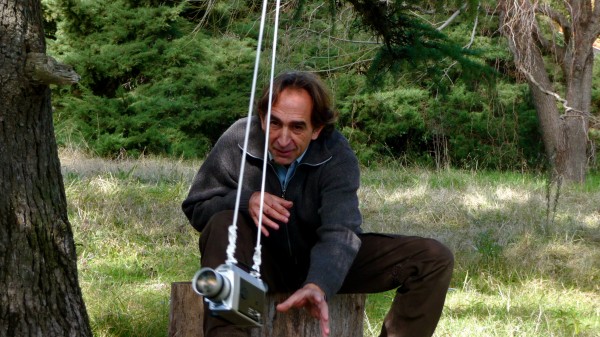
Claudio Caldini in a scene from Andrés Di Tella’s Hachazos (2011)
This interview with Andrés Di Tella was conducted during a retrospective of Di Tella’s films at last year’s edition of the Brazilian documentary festival It’s All True. All quotations from Di Tella’s book Hachazos were translated by Aaron Cutler from Spanish to English. All images courtesy of Di Tella unless otherwise noted.
***
A man brings all his work, all his life, inside a small leather bag purchased in India, on a train that goes from Moreno to General Rodriguez, by the western suburbs of Buenos Aires. They are the originals of his films, all in Super 8, an obsolete format, in danger of extinction, which does not allow the films to be copied. This bag is like the manuscript of his autobiography. It tells of Claudio Caldini, caretaker of a suburban villa, secret filmmaker.
These words open Andrés Di Tella’s 2011 book, Hachazos, which he calls “the diary of my encounters with Claudio Caldini.” The book’s subject is one of the survivors of a rich group of Argentinian experimental filmmakers who blossomed jointly in the 1970s, during the years of Argentina’s military dictatorship. (The nation resumed free elections in 1983.) Caldini’s films—twelve of which were digitally transferred and released on home video along with films by his compatriots last year through the boutique label antennae collection breathe like brilliant bursts. They are built with simple, repeated gestures, rendered in pulsating color: lit candles glide from front to back of a dark frame in Aspiraciones (1976); the bright green of leaves on branches soaks the screen as plants dissolve over each other in Cuarteto (1978). Sometimes, as in Gamelan’s (1981) fusion of a camera’s steady circular swing with a Steve Reich piece, the films are explicitly set to music. Their progressions of rhythms intensifying until reaching crescendo are always musical, regardless of whether the films have soundtracks. These are perfectly formed compositions.
Caldini’s life outside cinema has been far from one. His countryman Di Tella’s book tells—to the extent that its often closed, distant subject will allow—of how Caldini, dissatisfied aesthetically, politically, and spiritually, left Buenos Aires for the utopian ashram of Auroville in India. He ensconced himself so completely within his new community over the following six months that he was unable to readjust to Argentina upon his tourist visa-mandated return. He stayed inside his parents’ villa, then was sent to a mental institution, and closed himself within a series of walled spaces, including further trips to Auroville, throughout the 15 years that followed. The most sustained effort he made during this time—when he could make it—was filming. On his last trip to Auroville, he shot Heliografía [Blueprint] (1991), a record of a circular bicycle tour throughout which one senses the artist’s ghostly presence. Di Tella writes how, for him, the film sums up Caldini’s interest in exploring both nature and his perception of it: “The observer is part of what is observed and his gaze modifies what is seen.”
Di Tella could also be describing his own films. The half-Indian writer was born in 1958, six years after Caldini, and first met Caldini in the 1970s through his Hindu mother. Di Tella became a documentary filmmaker whose work has increasingly explored the tension he feels between himself and his very personal subjects. (Di Tella also founded Argentina’s largest film festival, BAFICI, in 1999, though he stopped working for the festival soon afterwards.) His early documentary, Montoneros, a Story (1994), a rigorous piece of journalism in which former members of Argentina’s strongest anti-dictatorship guerrilla movement recount life on the run while their faces betray both the pleasure and the exhaustion that they still feel from it, contains the filmmaker’s supportive feelings only implicitly. By contrast, his love for his subject is everywhere in the following year’s Macedonio Fernández (1995), a portrait of an Argentinian writer whose fictions inspire Di Tella’s film to create its own, including the possibility of having the author’s voice on tape. His love complicates The Television and I (2002), which begins as a search for the Argentinian television he missed while living abroad as a child, but becomes a series of discussions demonstrating his awkward relationship with his father, a television manufacturer, and a questioning of how his young son will grow up to feel about him. In Photographs (2007), Di Tella stretches himself even further. He gathers scattered documents to try to reconstruct his memory of his long-lost mother, then travels to India to meet relatives he’s never known, who tell him that they didn’t really know her either.
Di Tella interviewed Caldini for Photographs, though the footage ultimately was not used. In the decade following his last Auroville trip, Caldini moved through 36 different homes without steady work, finally settling down as the caretaker of a suburban villa. From 1998 to 2004 he served as the film and video curator at Buenos Aires’s Museum of Modern Art. He also, in time, began teaching a filmmaking seminar, found three Super-8 projectors, and transformed his art. What were once films became parts of performance pieces, with Caldini operating multiple projectors simultaneously. As part of the Hachazos project, Di Tella collaborated with him on several, performing research like transcribing interviews and reviewing photographs onstage while Caldini worked with his films. Di Tella eventually decided to make a film in collaboration with Caldini, though he knew that the work would be difficult. As he writes in Hachazos about the upcoming film:
The interesting thing about the project would be, certainly, that it would deal with two very different filmmakers, who incarnated two almost antagonistic conceptions of cinema. Narration and contemplation. Testimony and image. Figuration and abstraction. There was the conflict. It would not be a documentary about Caldini but a film made with Caldini. The record of a collaboration, a correspondence, a discussion.
Though Di Tella’s films are often both digressive and comic, his subjects determine their ultimate shapes and styles. Hachazos (2011), a companion piece to his book of the same title, is filled with long pauses and the sound of breathing, as Di Tella’s camera sits in close-up on Caldini’s face, waiting for him to speak. The film unfolds over a few days at the villa where Caldini works, as Di Tella tries to convince him to retell his story. Again and again, Caldini shrugs him off, saying that Di Tella is turning him into a fictional character. Di Tella doesn’t much disagree, and even goes so far as to enlist Caldini in staging literal reenactments of his filmmaking, with the older man once again swinging a camera from a tree and riding a bicycle in a circle.
Hachazos shows Caldini becoming a character in a story Di Tella is telling—a man whose life is incomplete without cinema. The closest we come to glimpsing this man’s inner workings is when we watch his films projected. It’s when Caldini projects pieces of Un nuevo dia (2001) —a reconstruction of a “disappeared” friend’s lost film made entirely according to his memories of the original—for Di Tella that he most fully shares his recollections of the dictatorship years. As he projects his films for his students, we glimpse the peace he has long sought.
A moment in both the Hachazos book and film shows Di Tella trying to read Caldini’s face after Caldini has described a dream he’s had. The dream is about living in a house that isn’t his; Di Tella speculates whether “the work of any artist, in any circumstance, is anything other than an inventory of his or her attempts to return home.” This speculation circles back to the project’s title, which in English means “Blows of the Axe,” and refers to the 1950s practice by Argentine distributors of chopping up film prints to prevent people from stealing and illegally projecting them. Caldini’s father, an electroplater and amateur film buff, would collect these film fragments and project them for his family at home. The Hachazos project, years later, shows both Di Tella and Caldini making art to project a fragmented past.
Often in documentaries, the story is told through archival footage and talking heads appear to flesh that footage out. In your movies, though, that seems to be flipped. Often it seems you’re presenting the past through archival footage, but the story is really in someone’s present-day face. Why?
I hate the idea of archival footage just illustrating what somebody’s saying. Often that’s the case, and I like to work against this practice. For instance, Prohibited (1997) uses the most archival footage among my films. I used news footage and official ads from the time of the military dictatorship in Argentina, but I was adamant that the footage would always appear with the effect that you were watching the thing in its entirety, for itself and not to illustrate something else, nor to be illustrated by someone else. I would sometimes leave the rough edges at the beginning or at the end, to give the feeling that you were watching the piece in its entirety, even in cases where I had edited quite a bit on account of length.
Still, I feel now that Prohibited’s narrative rhythm possibly pays the price for this. Montoneros, a Story is a different example. That film was originally made for TV in two 45-minute segments. It was a reaction against the format of the documentaries that I had been making for PBS, which were very, very anonymous and conventional, falling in line with archival footage of people talking and a narrator explaining everything. Here, we managed to give the few short pieces of stock footage that we had—it’s very difficult to get ahold of Argentinian stock footage in Argentina, and impossible to even think of buying international material—a narrative role in the film. They’re telling part of the story themselves.
I have to balance the facts that I want to be included or conveyed within the story that I’m trying to tell, because I’m telling stories, ultimately. Every moment that there’s somebody in front of the camera, something has to be happening. The moment must be alive. So I have to find some kind of unstable equilibrium between the fact that I need to tell a story and the fact that each particular moment has to have some life in it. People have to be vividly evoking something for themselves. Something has to be happening in a person’s face onscreen.
What interests you about Claudio Caldini’s face?
Caldini is somebody who can remain silent and make long pauses and remain somehow composed in front of the camera, which is a challenge but also a gift to the filmmaker. He is somebody who withholds a lot. This could be a disadvantage, and sometimes it is if you’re trying to make him tell a story and he won’t or can’t. But the fact that he will stop in the middle makes for a great documentary character, because at that point it invites the viewer in. One of the things you’re always looking for in documentaries is a way to allow the viewer in, not to have him just listen to a lecture. I tried to give Caldini a certain mystery as a way of providing doors through which viewers could enter. The less you give away about a character, the more the viewer has to imagine. And how does the viewer imagine the character? Through his or her own emotions and personal associations. I think that the viewer can thus try to imagine what is going on in Caldini behind his face.
How did you decide you would show his films?
Hachazos is not just a film but also a larger project, which includes a book. The project actually started as a piece of writing, with a strong biographical strand. Only subsequently did it develop as a film, which is far less biographical in its content. In between the book and the film, we jointly staged a series of performance pieces, with some theatrics, where I evoked different phases of the documentary process—reading documents, listening and transcribing interviews, reviewing photographs. And Caldini, on stage, would screen some of his material by operating multiple projectors. It was an odd kind of “live documentary,” made in the physical presence of its subject.
For somebody who’s only going to see the film, however, who’s never heard of Caldini or seen his work–and that´s the vast majority of the intended audience—the film has to work on its own terms, as a story. This film is not meant for experimental film buffs. The fact that Caldini is an experimental filmmaker, outside the conventional idea of what a filmmaker is about, is of course essential to the story. But in a way it is also almost incidental. He’s a filmmaker. He’s an artist. That´s what matters, as well as how, in a way, he’s a mirror for me.
But still, I had to show some of the work he has done. At one point I was thinking that it was impossible to include clips of his films, because I felt that the real experience of watching a Caldini film is actually in Super-8 projection, and even more so when it’s projected as he does in his performances, with three or four simultaneous projectors—he’s there, and the film gets stuck in the gate, and he has to cut it, and he’s sweating his head off. And that’s really where the magic lies.
So I knew that I would never be able to convey within my film the power that Caldini’s films have for me. But somehow, I needed them, because otherwise people might think that he was just a gardener. But I think that the film ultimately conveys Caldini´s uncompromising personality in such a manner as to convince the audience that what he’s doing is dead serious, however little you are allowed to see of it. What I did was to place his films within the context of an improvised screening that he was doing on a blanket inside his house for a small audience. We don´t see film clips, we witness a live screening. It’s just another scene within the film. It’s much more intimate. And it’s part of the story.
There’s a moment when you’re filming him during the last projection of his films and he’s blocking the middle of the frame.
Yes, because it’s a performance. And he’s part of the performance.
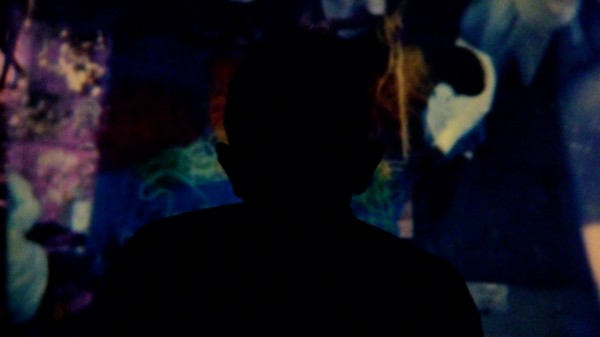
Claudio Caldini projecting his film, Tamil Nadu View (2010), May 2010. Photograph by Andrés Di Tella.
Hachazos’s most prominent sound effect is the whirring of a film projector. Why?
Partly because we were watching films all the time, and it was there. But there’s something nostalgic about its presence, too. Caldini is a fetishist about the materials of film stock and celluloid. I’ve never been—for years I’ve been shooting on tape, and then cards, or whatever it is that we shoot on now—but I do see something precious about the lost film world. Caldini is just the tip of that iceberg. He always considered himself a filmmaker, and never considered himself a visual artist, but 99 percent of Argentinian filmmakers today would not consider what Caldini does to be film. They would be happy if he said, “No, I’m doing art.” To me, though, connecting the identity of a filmmaker to the physical material of film is very moving.
Although I don’t partake in craving the material sense of celluloid, I do find that the loss of the experience of seeing films projected in a communal setting has impacted my life. Most of the films I see nowadays are on my computer or on TV. I hate for people to see my films in these contexts—I always thought that they were meant for the cinema, in the dark where you can concentrate and let your emotions work, whereas TV is the remote control. And yet the small screens are certainly where most people see my films. So you can be religious and say, “No, film must only be seen on film,” so Caldini’s films should only be seen in Super-8 projection in the dark, with Caldini himself projecting. And yet some of his films are on YouTube, and they have been released on Blu-Ray in the United States, and though he’s not entirely happy about this development, people get to see them. Some might be indifferent to what he’s doing, and some might say, “Wow.” And there’s hope in that.
How did you understand your own character’s role in the Hachazos story?
I say at one point that Caldini was the first filmmaker I saw in action. So he has always had this important symbolic dimension for me. I was still at school and he was shooting a performance by Marta Minujín, an important Argentinian pop artist who happened to be a friend of my mother’s. Minujín’s performance, called Autogeografía [Autogeography], consisted of symbolically burying herself alive. This was quite strong stuff in Argentina in 1976, when the anonymous corpses of victims of clandestine military repression were being buried by the hundreds. Caldini was shooting on Super 8 and I was throwing dirt on Minujín. This Super-8 footage appears toward the beginning of the film Hachazos.
In the rest of my film, Caldini is Caldini, the real person, but he’s also a bigger-than-life character in this story that I’m telling, and I wanted to make it explicit that I’m creating a character. To tell a story, you need a character, and a nonfiction character will always be a reduction or a magnification of a real person. I think that there’s a two-way phenomenon always happening with documentary characters. On the one hand, you’re inevitably reducing people, cutting out hours of footage, not to mention all that you’ve never even been witness to. So, in this sense, we’re a little bit like head-shrinkers. On the other hand, you’re paying so much attention to the slightest movement of a face, or to wordless breathing, and you’re working on the edit for months, striving to convey significance to each moment, that the character takes on a kind of monumentality. Suddenly it’s like you’re on Mount Rushmore! Making a documentary is always about navigating this mixture of head-shrinking and Mount-Rushmorization. The construction of this Caldini character, as with all documentary characters, is a work in process.
That’s why the discussion we have in the film over the symbolic nature of Caldini’s bag becomes so important. I saw that he had brought along all his films inside an old leather bag. You must remember these are all films shot on reversible Super 8, so that there are no negatives or extra copies, just the original prints. So I wanted to shoot a scene of the bag on the train. It seemed an appropriate symbol, both of his itinerant life and of the fragility of the artist and his work. But he refuses to play along. I saw the bag with the films. But he says that that only happened once. Does the fact that it only happened once make it untrue? Is it not representative, therefore not real?
Including the conflict over the bag was a way of pointing to the conflict in all documentaries between storytelling and reality, fact and fiction. Caldini himself says at one point: “This is fiction. This isn’t something that I would do. I don’t feel comfortable doing that.” There are other points where he says, “I don’t think this conversation is going anywhere,” or “It’s not organized properly.” I value comic timing very much, and I think it’s welcome in documentaries, especially this quirky thing where sometimes you don’t know if it’s supposed to be funny or not. So, on a basic level, the scenes are funny. But I really put those moments of disagreement in to show a tension between the real person and the character in a story. Like the bag, the Caldini of my film is torn between the man and the symbol.
My own character—the “filmmaker”—has an important function as a stand-in for the spectator. In a way, the question of the film becomes: why am I interested in this man? My character is looking for something and possibly finds in Caldini something other than what he was looking for. There is no pretense at objectivity. Often in documentaries the relationship between the people making the film and the people being filmed is hidden. And sometimes this raises an ethical concern, which is why is that relationship hidden? I wouldn’t go so far as to say the stuff behind the scenes is the most interesting—it has to be in homeopathic doses, because it can be too much of a good thing—but what’s really happening in a documentary is the development of a relationship between the filmmaker and the subject.
As a result, there’s always a little bit of “meta” in my films. I must confess that I am always curious for making-of stories. I often prefer books about how a certain book was written over the original book itself. For instance, I recently bought Boswell’s Life of Johnson, and I had a hard time plowing through it. Then a friend said, “You have to read the book about Boswell, which is much better.” It’s a wonderful book about the making of The Life of Johnson, and it helped me. I have this unhealthy appetite for the how it was made, both in other people’s work and in my own. Hachazos is autobiographical, as is Photographs (2007), both of which are films that are reflexive about the filmmaking process, even to the point of using outtakes. There’s one moment that I particularly like in Photographs that happened because the cameraman Victor Gonzalez had either forgotten to turn the camera off or accidentally turned it back on. He was cleaning the camera lens and complaining about the fact that I was late. We’re on a shoot in India and the director is late! You only catch half of what he’s saying, because the camera’s out of control. And that scene, to me, conveys my situation of being in India, trying to make a film about my family, feeling jetlagged and in a feverish state, unable to organize a film around what I wanted to do, more than anything else that we shot. The moment was a mistake, something that should have been thrown on the cutting room floor, and yet it was alive, and it was saying a lot about what was happening.
So I never use this background making-of material just for its own sake. It’s always telling part of the story. These discussions between Caldini and me over how he’s being represented in Hachazos go to show you that it’s not just his story. It’s also my story, as well as ours.
How did the collaboration between you and Caldini work? How did you shape the film together?
That’s a very good question, but it’s not easy to answer. Part of the process went simply as it does in any documentary. You propose something and the other person accepts it or turns it down, or he may propose something that you are interested in or not. Sometimes, even if you don’t like the person’s idea, you film it in the interest of placating him or her, and it may surprise you. In this case, I suggested we reconstruct how he shot his old films because I basically didn’t know what we were going to shoot besides his work as a gardener! But I suspected that something might come of it.
What Caldini does, when he’s making a film, would not be recognized by most filmmakers as pertaining to the same activities that they pursue. That’s why I thought it would be interesting to see him hanging a camera from a tree or swinging it over his head like a lasso or shooting from a moving bicycle. At one point he had been painting Super-8 frames in ink and I wanted to show him washing his hands afterwards. But he refused to let that be included because of the calamitously messy state of his bathroom. To me, the bathroom was evidence of how he didn’t care about material success, but to him it was possibly humiliating. In general, he was very happy for us to be there making a film about him, but he was not happy to be portrayed as the caretaker of a villa. He wanted to be seen as a filmmaker. But he was both things.
He had some other objections to the film of Hachazos, like the sequences not respecting the order of the seasons or there being too many cuts—points that conflicted with his own ideas about filmmaking. But I think that one of the major things that he didn’t like was that the film was showing something that he wanted to hide, even though he had let us in. In my experience, people have very strange ideas about what a film is going to do, what it’s going to show and what’s it going to tell. They always imagine something, but it’s a secret, like a secret desire that often remains hidden even to themselves. And it’s rarely the same thing that you have in mind, no matter how much you’ve explained your aims. I think that documentary subjects believe that they will be able to control the film much more than they can. I mean, I can’t control the film that much myself, even though I spend months trying to make it mean one thing and not another. But I am also learning to let go, to let the film tell me what I have to do.
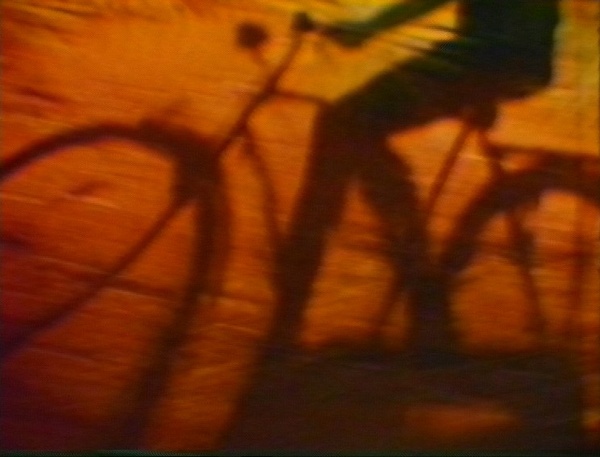
Image from Claudio Caldini’s Heliografía (1991) (Image courtesy of Centre de Cultura Contemporània de Barcelona)
With all that said, I worked with a lot of trust, which came from the investment in hours and hours of being with this guy and talking and writing, and so Caldini wasn’t nervous. For me, trust is basic. But even within that trust, the other guy could be thinking that you don’t know what you will end up doing, and you could be feeling the story dictating certain decisions that you can’t go against, even if you know that he might not like them. For instance, I found the last shot of the film, a close-up of Caldini as he leaves the villa on the back of a truck, pretty powerful. As we said, his face has a wonderful quality that allows you to project onto it, but at the same time it retains this opacity that prevents you from really knowing what is going on inside his head. And he hated that shot, because he said he looked sad—he would have closed with a previous, slightly wider shot, where he seems to be in better spirits. But to me the film had to end on a close-up, because it’s a portrait. I couldn’t take it away, despite what he said.
How did you find the film’s structure leading up to that?
I think that the story structure of Hachazos came partly out of the experience of shooting it. There’s this idea that film characters must turn in a way, undergo some kind of transformation, make some kind of change. It was so difficult to get Caldini to reveal himself that the film became predicated on how, at a certain point, we fail. I almost give up. Until I come across an idea. He made this film about this other experimental filmmaker—he actually never finished it, but he made the attempt. So I thought, let him tell this other story and maybe that way I can get to his.
I had been interested in the film that Caldini couldn’t make, but I hadn’t previously thought that it would become a turning point. In truth, I discovered this turning point in the editing room. Editing was tough. We made this film for about $40,000—not much money at all for a film—so I edited myself for a long time. I had an editor who is also a filmmaker, Felipe Guerrero, come in for a month to reedit my cut. I had some more time with the film by myself and then he came in again for two more weeks and that was that. The way it is with an editor, sometimes you stay away for a few days while he works and then he shows you something. You want somebody to help you. Not just that—you want to lose power, you want somebody else to make the decisions. Felipe made me throw out an entire subplot. He was very good, because he had ideas that were contrary to mine, and he fought for them. That´s the most you can ask of an editor, to fight for his own ideas.
What was Caldini’s role in the editing room?
None. I showed him a pretty advanced cut. He had previously read several manuscripts of the book, and he had seen some of the film material because we had created the performances. (We did some before making the film and some after the film’s release.) Still, he compiled a long list of suggestions and objections, mostly formal. I could take care of two or three out of the list. But this is essentially because we are two very different filmmakers. To put it starkly, I believe in stories and he doesn’t. He’s a poet, and I’m a prose writer.
He later wrote to me, though, that he had become reconciled with the portrait of himself in Hachazos, and that he had never seen anything resembling my film, which coming from him was the highest form of compliment. I think he was happy with the general result of the film, and of course it generated a lot of interest in his work. In his long filmmaking career, he never had so much press! But what he thought he was going to convey through the film, what I thought I was going to convey, and what the film actually conveys are three different things. On the other hand, he loved the book and had very little to say about it.
How is the book Hachazos different from the film Hachazos?
Well, it’s writing as opposed to sound and images. And this is obvious, but even a talkative film, as most of mine are, likely won’t have as many words as the front page of a newspaper. The book, which is not very long—about 120 pages—still has enough words that you can explain in some detail a lot of circumstances that in the film may be simply assumed or alluded to at most. And the basic difference is that images allow for much more interpretation.
The book also has pictures to go with the words, to which all the reviews said, “Sebald.” Which is great, because I love Sebald, although I wasn’t thinking about him. But some of the major influences in my work are books rather than films. V.S. Naipaul’s mix of history and crossed destinies, his notion of the wrong man in the wrong place meeting another wrong man, was deeply influential in my work—or maybe my life—as is the emotional rawness in his writing about India and about his Indian family. I appreciate a lot of work in this memoir/nonfiction vein, and read all of what in Spanish we call auto-ficción. It’s a strange term. It’s not autobiography—it is autobiographical, but it doesn’t have to be the full truth. Ricardo Piglia is an Argentinian author who is constantly introducing mistruths into what he has written. We made a film together called Macedonio Fernández about the writer that Borges considered his master—some people think that Borges invented Fernández, and in a way he did. Piglia had an idea that I think is related to Caldini’s bag, which is that he had received a tape recorder from somebody that had a recording of Fernández’s voice on it. At that point I was uneasy about introducing a straight-out lie in what was otherwise a documentary, but I did it, because of the symbolic dimension it created and because it allowed us to introduce the idea of the mystery of a voice. Where does it come from?
There’s something interesting about the Argentinian attitude toward this kind of thing. I was recently talking to a young Argentine author named Patricio Pron who lives in Spain, and who wrote a book about his parents called El espíritu de mis padres sigue subiendo en la lluvia [The spirit of my parents keeps rising in the rain]. It’s quite a nice book. He said that in Spain everybody took it literally, as an autobiography. By contrast, in Argentina I asked him, “Is everything true?” And he said, “Everybody in Argentina asks me this.” We’re pretty skeptical. I don’t know why.
Does it have to do with politics? You say in The Television and I that “[a]s an Argentinian, it’s impossible not to talk about politics.” Politics seems to be everywhere in your films. And you end up addressing politics in this film through the effect that censorship had on the Argentinian avant-garde.
Not quite censorship, but rather simply living under dictatorship. I’ve lived in England and in the United States, and I think a lot of people in First World countries don’t really have a notion that their lives are changed or shaped or diverted by politics. Whereas in South America everybody knows that this is the case. It’s very hard to live here without awareness of one’s political circumstances. Claudio Caldini is a perfect example of somebody who was never even remotely interested in politics, and yet whose life was changed by it.
I really like stories with an epic feel, and I think that that feeling usually comes from the intermingling of an individual’s private life with the winds of history and of political change. This intermingling is often tragic—you imagine something completely romantic, your expectations are dashed as it becomes a dictatorship instead of a socialist utopia, you end up in a dungeon and you have to survive. That´s the narrative of Montoneros, a Story. I discuss in the book Hachazos how Caldini went from Argentina to Auroville, which is meant to be a utopian place in India. In my own life I’ve traveled as well. My parents left Argentina for England in 1966 because of the dictatorship, and I myself went to study abroad in 1976 on account of a new military coup. Even though I wasn’t a political exile, I can still identify with Caldini. You couldn’t breathe in Argentina. It was a numbing and oppressive atmosphere, even if you weren’t part of the guerrillas or being actively persecuted. It wasn’t just that they persecuted political opponents—they cut out all the sex scenes out of the movies!
At the same time, as Beatriz Sarlo, a prominent Argentinian writer who edited an underground magazine back then, says in Prohibited, “Some of the happiest moments in my life happened during the dictatorship.” The intensity of what was at stake made simply editing a little literary magazine that hardly anybody would read into something epic. It was an act of resistance, deliberately and consciously so. Caldini’s Super-8 films were, too. The stuff that he was making, both the films and the screenings he held of them, offered a resistance to the dictatorship. Making films that people couldn’t understand was subversive. And of course Caldini was a utopian, because he imagined that someday everyone would be able to see and understand them.

An image of Andrés Di Tella’s notebook, taken from Hachazos (2011)
Text 1: In 6 minutes of film he synthesized 6 years
Text 2: The three screens
Text 3: To make films the same way we live/To live the same way we make films
At the end of the film Hachazos, you say that the next film you make will be different. What does this mean?
It’s a way of acknowledging the transformation that I’ve been through. I am a different filmmaker from the one that began the film. Hopefully it will somehow echo the experience of the viewer. But is also something I feel whenever I’m finishing a film. Making a documentary is often tantamount to digging yourself into a hole in order to try to dig your way back out. It’s a way of swearing that I will never make the same mistake again. But it’s also a variation on Beckett’s famous words: “Ever tried. Ever failed. No matter. Try again. Fail again. Fail better.”
Postscript: Both Caldini and Di Tella have premiered new film works since the Hachazos project’s completion.
]]>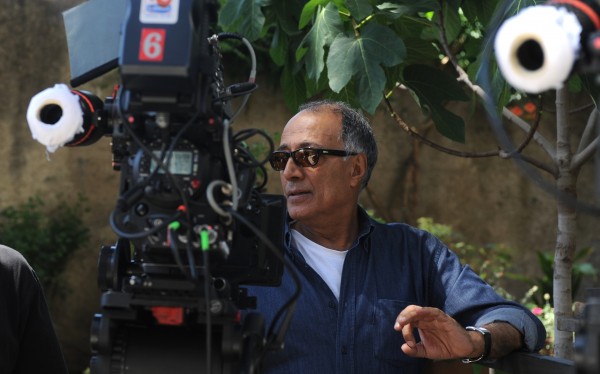
Abbas Kiarostami on the of Like Someone in Love. Image courtesy of IFC Films.
This interview was held at this year’s São Paulo International Film Festival. The Iranian filmmaker Adel Yaraghi, whose first feature Meeting Leila was co-written by Kiarostami, translated Kiarostami’s answers from Farsi to English.
In your absence
I converse with you,
when you are there
I converse with myself.
– Untitled Abbas Kiarostami poem, published in his collection A Wolf Lying in Wait
Like Someone in Love begins in a bar, with the sound of a disembodied voice on a phone. In time, a young woman on a mobile comes into view. She is speaking with her boyfriend, who is interrogating her. As the night goes on, Akiko (Rin Takanashi), a university student longing for sleep, will ignore his demands in favor of propositions from two lonely elders: her grandmother, who is in Tokyo for the night and leaving numerous voicemails, and Takashi (Tadashi Okuno), an old sociologist and translator who has hired her to spend the night with him. Shortly after she enters his home, he shows her a portrait that he considers his ideal woman, and encourages her to stand beneath it.
Both Akiko and Takashi, we sense, have worked to shield themselves from interacting with real people, and the film’s visual design reflects this. For Akiko, whose refuge is sleep, the solution to conflict lies in moving offscreen; for Takashi, who lives in a fragile fortress of memories, the solution is to build frames for himself and live subsequently behind closed doors. Yet the two are far from alone in walling themselves inside their individual realities, as each person they meet—most notably Akiko’s boyfriend Noriaki (Ryô Kase), a car mechanic who demands that her “grandfather” accept him, and Takashi’s old female neighbor (Mihoko Suzuki), who leans out her window dreaming of marriage—has also built his or her own. The film’s Tokyo is an isolated and isolating place; the most extended view that we get of the city is from inside a taxicab, as Akiko looks for someone she knows. In this place, a knock on a car window can seem like a violation.
This conflicted worldview, in which one opens oneself to discovering a place while still feeling troubled by one’s foreignness to it, and even desiring to keep oneself apart from it, belongs unmistakably to the film’s director, the Iranian Abbas Kiarostami. The brave new worlds that trouble his characters often include beloved humans as well as new locations—in fact, the emotional distance between two people often proves harder to cross than any road. Yet though this latest film follows a career-long attempt to traverse that distance, its approach is new. Its method is less like the mobile pursuit of pleading, or erupting, couples in many of Kiarostami’s previous films, including his recent Italy-set feature, Certified Copy (2010), and more like a distilled succession of frozen moments involving solitary people. It is as though the film itself is contemplating a solitude that has already long been realized.
This solitude belongs to the filmmaker’s gaze as much as it does to any character’s. Something often lost in discussions of Kiarostami’s filmmaking, and perhaps forming more appropriate comparisons to Like Someone in Love than his previous films, are his parallel careers as a poet (with two collections published in English) and as a still photographer (many works of which can be glimpsed in the 2005 short film Roads of Kiarostami). In both he strives, as he does here, to record first-person impressions. The poems, usually falling between two and six lines, register quiet instants of appreciation (“A young moon/an old wine/a new friend”); the photographs, often in black and white, feel equally illusory, capturing natural beauties like trees and paths quickly and from a distance. As with Like Someone in Love, the images of both the poems and photographs linger after vanishing, regardless of whether their subjects seem physical or ephemeral. Love, too, is a sight that one catches.
What are the major differences for you between being in love and being like someone in love?
I think being in love is a period into which we fall and out of which we fall. It’s a temporary period, and not one that goes on forever. Having said that, this title would be applied to anybody who is in love, because after we fall out of love we think, “How was it that I fell in love, and how did I spend that period of time?” This happens even with the classic love affairs that we experience in literature, or that we have in real life. To talk about the four main characters of the film—the old gentleman, the girl, the boyfriend, and the old man’s female neighbor—this title would apply to all of them.
How did you come to make a film in Tokyo?
The idea for the film came from a single image that I saw when I was in Tokyo many years ago. We were passing by a neighborhood very late at night, a neighborhood full of businessmen in black suits, with black ties and briefcases, all very businesslike. They were surrounding a young girl who was wearing a wedding gown. The image of the white wedding gown between all these black suits was very interesting to me. When I asked what she was doing in between all these men, I was told that she was one member of a group of young women who would come to Tokyo and, in order to pay their university tuition, would work part-time as escorts for businessmen. This image led me, years later, to make a film about the girl.
To build a character, in any script or book or story, you have to have a character’s background. I imagined this girl as someone who had come from a small town to a big town to live and work and study. So the starting point for the film was her and her situation, and then other characters gathered around her. As is necessary for any story, I had to find a group of people to be with her in order to explain her character more. I had to bring these other characters into the story to help create and show her, to help bring her out from being a cardboard character to a character with perspective and three-dimensionality. It soon came naturally that she would be surrounded by some men, such as her pimp, the old man, and her boyfriend, and so they became part of the story as well.
Naturally, in going from writing the script to actually filming the story, we tried to envision this character of the girl and the surrounding characters as best as we could in all aspects. We cast the actress that I thought would be most right for the character, then I chose a pimp, and I chose her girlfriend, and her boyfriend, and all the people that she was involved with.
You establish a pattern at the beginning of Like Someone in Love in which people are isolated from each other spatially. There are characters who are speaking to each other but who do not appear in the same shot. Why?
This film is radical in that it doesn’t have a specific beginning, nor does it have a specific end. We are never on time for any story. In real-life situations we always get into the story late, and we always leave the story too early. So this was a chance for me to emphasize that in a radical way—to emphasize that this is how it is. We start the film, or any story that would surround us, by hearing first. Even if we take this hotel where we are having our interview as an example, if there is an interesting story going on, if it were to catch our attention it would be through aural means first. And then if we were interested, then we would want to seek the story out with our eyes and watch it. In this film I used the same technique—or the same pattern, as you might say. We get into the story by hearing it first, and then, once we’ve heard enough to be interested, wanting to know what will go on next, then we go to the visual part. So this was a technique that I used to emphasize a reality that exists.
What interested you about the reality that you were filming?
My first sight of Tokyo was a touristic vision. I saw it as a tourist, more so than from looking at it with a Japanese point of view. But what remained with me afterwards, and what was interesting to me, were the traditional Japanese ways of life and culture. I knew them from being in Tokyo my first time, and being there again reiterated my feelings and made me want to see these things once more.
Sometimes I think that my familiarity with Japan came out of my experience of watching Yasujiro Ozu’s films, which were shown in the Tehran cinematheque when I was 20. But when I think again, I feel that it might be that my familiarity with Japanese culture and with the Japanese way of life is even older than that. I think that it might come from the haikus that I read when I was young. They deal very much with images, and explain images in poetic form, and to me they have a lot to do with the Japanese way of looking at life.
I also started photography more than 35 years ago, and if you ever see my photographs, you will see that they are very similar to Japanese homemade black-and-white paintings. So my familiarity with Japan is very old. I don’t know where this familiarity started, but I feel that it comes from way, way back in my life.
You are also a poet. What do you see as the commonalities between your poetry and your cinema?
The main similarity lies in their starting points. They both come out of the same person, and they both come from the same way of looking at life. They both explore things that interest me, like Nature or naturalistic people—introverted people who are natural and real. So I think that the poems are like the films, only, instead of being put together by frames, they are put together by words. The works in both forms are similar to each other, and they influence each other as well.
Tehran, Tuscany, Tokyo: Where is next?
I wish Iran, but if it does not happen, Italy. There are two different projects that I’m working on, so whichever project is more possible, then that place will be next.
Like Someone in Love opens through IFC Films on February 15.
]]>
